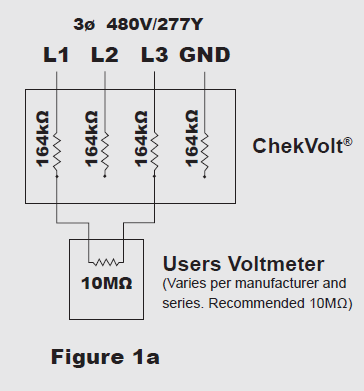A: A Voltage Reduction is displayed on your multimeter when using any of our Voltage Test Point products. This includes our Safe Test Point (R-3MT, R-5MT, R-3MT-1K, etc.) and our ChekVolt (R-3MT-VI Products). This is because there is internal high impedance in these devices in order to limit the current to below 5mA in all cases, which is the OSHA standard for shock hazard. The principle behind this is the same as a Voltage Divider. When using a Voltage Test Point PESD, there is a Voltage drop across the PESD that is based on the ratio between the PESD Internal Impedance and the Voltmeter Input Impedances. So with a higher Input Impedance meter, the voltage reading reduction is lower.

This Voltage reading reduction is dependent on the Voltage Test Point product used as the internal impedances vary between models and the Input Impedance on the multimeter itself. This error can be as low as 2% or as high as 39% (uncommon).
R-3MT & R-5MT (102kΩ): 2% Error when used in conjunction with a 10MΩ Meter; 470V Phase to Phase Reading on 480V System
ChekVolt (R-3MT-VI) and R-3MT-1K (164kΩ): 3% Error when used in conjunction with a 10MΩ Meter; 465V Reading Phase to Phase on 480V System
Multimeter Input Impedance: If you are not sure what Input Impedance your meter is, this can be found generally by contacting the manufacturer; it is not typically included as a specification in the datasheet.
The Input Impedance for Fluke's multimeters is typically 10MΩ. Fluke Clamp Meters are 1MΩ Input Impedance. The exception is the 11x series multimeters (the 114, 115, 116 and 117); these models have 10MΩ impedance for DC Voltage and 5MΩ for AC Voltage.
More Information: For more details, we have two Technical Notes that cover the High Impedance impacts of our PESDs.
R-3MT & R-5MT (102kΩ): High Impedance Technical Note
ChekVolt (R-3MT-VI) and R-3MT-1K (164kΩ): ChekVolt High Impedance Technical Note
